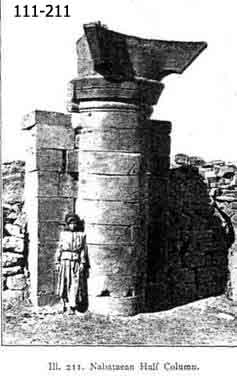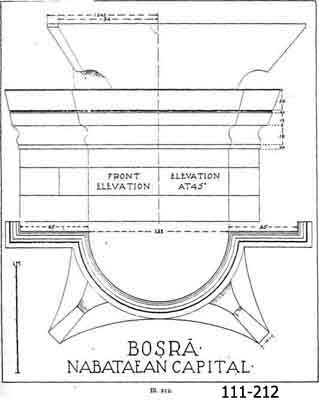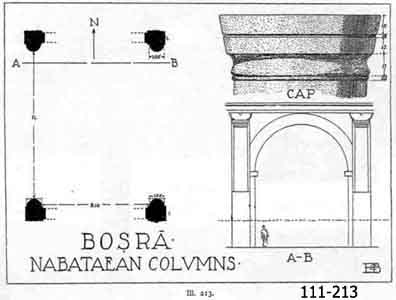|















|
|
Nabataean Remains
|
Before taking up in order the description of other
structures in Bosra which belong certainly to the period of Roman
domination in Arabia, and which are in a better or a worse state of
preservation, it may be well to give a description of some remains of
ancient buildings which bear a different mark from the edifices of the
Roman or Christian periods, and which seem to be allied with
architectural monuments which are known to be older, and to have been
the work of the Nabataeans. These fragments have a striking
resemblance to details of architecture found at St' in the Djebel
Hauran, which are known by inscriptions in Nabataean script to belong
to the first century of this era. Some of them are closely allied with
the architectural features of the rockhewn tombs of ancient Hegra,
near Medâin Sâleh, which are also known to be of Nabataean origin and
of early date, and all are suggestive of the style of architecture
illustrated in some of the famous rock-hewn façades of Petra which,
for lack of inscriptions, are to be classed with the other monuments
by analogy. |
|
It may be said at the outset that Nabataean
inscriptions are found in almost ever}' quarter of the city; but
that the remains of buildings and the fragments of architectural
details that can be called Nabataean have all been found between
the East Arch and the line of the east wall of the town. The
most conspicuous monument of this class is a tall half column
engaged with a broad pier, which stands about 25 m. to the
eastward of the East Arch. The scale of this half column (111.
211) which is 1.32 m. in diameter, suggests that the building to
which it belonged was one of fairly large dimensions; but all
other signs of a building in the vici-nity have disappeared, or
are completety hidden in the closely packed cluster of modern
dwellings that now occupies the spot. The half column itself
rises 4.50 m. above the flat earthen roof of one of these
dwellings, and the photograph was taken from that roof. To this
height we may add at least 3.50 m. for the height of the house,
and not less than 2 m. more for the depth of the accumulated
soil above the original level upon which the base of the column
rests, which will give 10 m. or between eight and nine
diameters, as the height of the column. The capital here is the
detail which attracts attention (111. 212), and I |
 |
|
|
have prepared a measured drawing on large scale to
illustrate it. The drawing and the photograph both show a set of
mouldings, an ovolo and a cyma recta below two slanting fascias
separated by a groove of triangular section —, which compose a sort of
echinus, and a high and heavy abacus with concave sides and salient
angles which are cut off square at the ends and bevelled inwards at a
steep angle to meet curved surfaces which carry the concave lines of
the top of the abacus to the convex line of the semicircular top of
the echinus. A projecting boss has been broken from the middle of the
top of the face of the abacus. It appears that the
mouldings of the echinus were returned outward on either side, and
prolonged across the top of, the broad pilaster with |
 |
which the half column is engaged, but
it is not to be known how the pilaster was treated above this
moulding. This peculiar abacus which is the dominating feature
of the capital, taken together with precisely similar details in
the rock-hewn façades of Hegra and Petra and in one of the
temples at Sic, may be said to create a new architectural order.
In the façades alluded to this abacus appears with and without
the moulded echinus; in the earliest type it is found as the cap
of a flat pilaster with only a simple moulding below it; but it
occurs also in connexion with an abacus, substantially like
this one, as the capital of a half column, in façades that are
known to belong to the first century a. d. In Hegra a small
member, not unlike a primitive volute or a minute leaf, often
appears underneath the salient angles of the abacus1. The order
in the tomb façades of that place is completed in several
different ways; in the simpler tombs by a plain architrave, a
torus, and açavetto cornice which is frankly Egyptian and
plainly shows Ptolemaic influence, although in these same tombs,
where an abacus of this type occurs as the cap of a pilaster
flanking the doorway, the
|
|
|
order above it consists of an architrave moulded at
the top, a plain frieze, and a cornice made up of several mouldings ,
all beneath a pediment with raking cornice that is quite Classical in
effect .In other tombs which are still early a moulding is given to
the top of the architrave, and a plain frieze is inserted between the
architrave and the cavetto cornice3. In a third type, in which a
moulded echinus like the Bosra example is inserted below the abacus,
the architrave and frieze are surmounted by a cornice of Classical
appearance, and the Egyptian cornice is elevated upon an Attic
storey4, and again, usually in portals, capitals of this style carry
an entablature with a complete Doric frieze of triglyphs and metopes5.
The fact that this sort of capital is found only in places known to
have been occupied by the Nabataeans, and usually in connexion with
Nabataean inscriptions, gives a reason for referring this detail to a
Nabataean origin, and for applying the name Nabataean to the Order, at
least in its simpler and less Classical form. Due east of the
Nabataean half column, and about 100 metres distant, stands a group of
similar half columns, three of which are without capitals; but the
fourth retains the lower part, that is the echinus, of a capital
similar to that described above and shown in illustrations 211 and
212. The group is almost completely hidden by modern dwellings and
stables, and a considerable part of each half column is deeply buried.
Each half column is engaged with a pier 1.20 m. wide and 1 m. deep.
They stand at the angles of a rectangle, 8.10 m. by 11 m., facing
inwards (111. 213). The two on the south are directly in line with the
Nabataean column described above. The outer faces of the piers have
finished surfaces, but the inner faces of the north pair and the south
pair have projecting pilasters which are now much lower than the
columns, and appear to have carried arches. The half column which
stands at the southeast angle of the group is the only one of the four
of which the lower part can be seen, and this shows that the half
column was set upon a rectangular pedestal, or perhaps it would be
more accurate to say that the lower part of the half column takes the
form of a pier; for there is no sign of a base above the pedestal the
sides of which are tangent to the semicircle of the half column. The
amount of data to be secured here is so small that it is well-nigh
impossible to suggest a probable restoration even for one pair of the
piers, and it is quite out of the question to hazard a conjecture as
to the probable extent or purpose of the structure of which they
formed a part. Two facts however may be significant: The southernmost
pair of piers stand in line of columniation with the Nabataean half
column, and the distance between the two pairs is about equal to the
width of the East Arch. And, since the half columns of the two pairs
face each other, they may be thought of as standing on opposite sides
of a street, 11 m. wide, that led eastward from the East Arch at an
obtuse angle with the main east-and-west street of"the city. In
A-B of the drawing (111. 213) I have taken one pair of piers, and,
assuming a depth of soil of about 2 m. , have shown two
pedestals |
|
rising 2 m. above the line of the soil,
this being the height of the one visible pedestal. From
the pedestals rise the shafts of the half columns, and
from one to the other of the pilasters on the inner sides
of the piers I have thrown an arch. The capitals have been
restored from the other Nabataean half column on the basis
of the single echinus which is still in place, and is
shown in detail in the drawing, and over these I have
placed a purely conjectural epistyle, such as one might
find in examples at Petra. Nothing, however, short of the
removal of the present houses and a thorough
excavation of the site, can reveal the original
arrangement of these very interesting architectural
details which probably belong to the early period of
Bostrian history.
|
|
 |
| |
|
|
